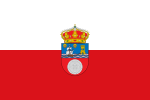Cantabria
| Cantabria | |||
|---|---|---|---|
| — Autonomous Community — | |||
|
|||
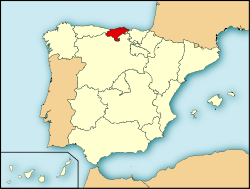 |
|||
| Coordinates: | |||
| Country | |||
| Capital | Santander | ||
| Government | |||
| - President | Miguel Ángel Revilla Roiz (PRC) | ||
| Area(1.05% of Spain; Ranked 15th) | |||
| - Total | 5,321 km2 (2,054.4 sq mi) | ||
| Population (2009) | |||
| - Total | 591,886 | ||
| - Density | 111.2/km2 (288.1/sq mi) | ||
| - Pop. rank | 16th | ||
| - Percent | 1.27% of Spain | ||
| ISO 3166-2 | S | ||
| Anthem | Himno de Cantabria | ||
| Official languages | Spanish | ||
| Statute of Autonomy | January 11, 1982 | ||
| Parliament | Cortes Generales | ||
| Congress seats | 5 (of 350) | ||
| Senate seats | 5 (of 264) | ||
| Website | Gobierno de Cantabria | ||
Cantabria (Spanish pronunciation: [kanˈtaβɾja]) is a Spanish historical region[1] and autonomous community with Santander as its capital city. It is bordered on the east by the Basque Autonomous Community (province of Biscay), on the south by Castile and León (provinces of León, Palencia and Burgos), on the west by the Principality of Asturias, and on the north by the Cantabrian Sea.
Cantabria belongs to the Green Spain, the name given to the strip of land between the Cantabrian Sea and the Cantabrian Mountains in northern Spain. It is called green because it has particularly lush vegetation, due to a wet and moderate oceanic climate. Its climate is strongly influenced by Atlantic Ocean winds that get trapped by the mountains; the average precipitation is about 1,200 mm (47 inches).
Cantabria is the richest region in the world in archaeological sites from the Upper Paleolithic period, although the first signs of human occupation date from Lower Paleolithic. The most significant cave painting site is the cave of Altamira, dated from about 16,000 to 9,000 BC and declared, with nine other Cantabrian caves, World Heritage Sites by UNESCO.
The modern Province of Cantabria was constituted on 28 July 1778. The Organic Law of the Autonomy Statute of Cantabria was approved on 30 December 1981, acquiring in that way fields, bodies and institutions of self government.
Etymology
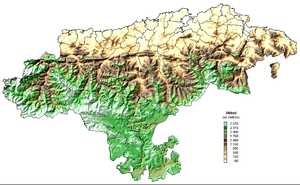
Numerous authors, including Isidore of Seville, Julio Caro Baroja, Aureliano Fernández Guerra, Joaquín González Echegaray, and Adolf Schulten, have explored the etymology of the name "Cantabria", yet its origins remain uncertain. It is generally accepted that the root cant- comes from Celtic or Ligurian for "rock" or "stone", while -abr was a common suffix used in Celtic regions. Thus, "Cantabrian" would mean "people who live in the rocks" or highlanders, a reference to the steep and mountainous territory of Cantabria.[2]
Geography
Relief
Cantabria is a mountainous and coastal region, with important natural resources. It has two distinct areas which are well differentiated morphologically:
- Coast. A coastal strip of low, wide and gently rolling valleys some 10 kilometers in width, whose altitude does not rise above 500 meters, and which meets the ocean in a line of abrupt cliffs broken by river estuaries, creating rias and beaches. Santander Bay is the most prominent indentation in the coastline. To the south, the coastal strip rises to meet the mountains.
- Mountains. This is a long barrier made up of abruptly rising mountains parallel to the sea, which are part of the Cantabrian Mountains. The mountains are mostly made of limestone with karst topography, and occupy most of Cantabria's area. They form deep valleys oriented north-south. The torrential rivers are short, fast flowing and of great eroding power, so the slopes are steep. The valleys define different natural regions, delimited physically by the intervening mountain ranges: Liébana, Saja-Nansa, Besaya, Pas-Pisueña, Miera, Asón-Gándara, Campoo. To the 'mountain' region belongs the Escudo Range, a mountain range of 600 to 1,000 metres high that covers 15 or 20 km in a parallel line to the coast in the West part of Cantabria.
Towards the south are higher mountains, whose crests mark the watershed between the drainage basins of the Rivers Ebro, Duero and those that flow into the Bay of Biscay. These peaks generally exceed 1,500 m from the Pass of San Glorio in the west to the Pass of Los Tornos in the eastern part: Peña Labra, Castro Valnera and the mountain passes of Sejos, El Escudo and La Sía. The great limestone masses of Picos de Europa also stand out in the southwest of the region: most of their summits exceed 2,500 m, and their topography is shaped by the former presence of glaciers.
Climate

Because of the gulf stream, Cantabria, as well as the rest of "Green Spain", has a much more temperate climate than might be expected for its latitude, which is comparable to that of Vermont. The region has a humid oceanic climate, with warm summers and mild winters. Annual precipitation is around 1,200 mm at the coasts and higher in the mountains. The mean temperature is about 14°C. Snow is frequent in higher zones of Cantabria between the months of October and March. Some zones of Picos de Europa, over 2,500 meters high, have an alpine climate with snow persisting year round. The driest months are July and August, although droughts are unknown because rain is frequent and temperatures never get particularly high.
The mountainous relief of Cantabria has a dominant effect on local microclimate in Cantabria. It is the main cause of the peculiar meteorologic situations like the so-called "suradas" (Ábrego wind), due to the foehn effect: the south wind coming down from the mountains blows strongly and dry, increasing the temperature closer to the coast. This causes a decrease in air humidity and rainfall.
These conditions are more frequent in autumn and winter, and the temperatures are commonly higher than 20°C. Fires are often caused by this type of wind: one example is the fire that destroyed part of the city of Santander in the winter of 1941.
In the southern part of the mountain range, conditions are different: wind there is fresher and more humid, and there is more rain.
Hydrology
The rivers of Cantabria are short and rapid, descending steeply because the sea is so close to their source in the Cantabrian Mountains. They flow perpendicular to the coastline, except for the Ebro. They also generally flow year round due to constant rainfall. Nevertheless, the rate of flow is modest (20 m³/s annual average) compared to the other rivers of the Iberian peninsula. The rapidness of their waters, caused by their steep descents, gives them great erosive power, creating the narrow V-shaped valleys characteristic of Green Spain.
The environmental condition of the rivers is generally good, although increasing human activity due to rising population in the valleys continues to pose a challenge.
The main rivers of the region, sorted by drainage basin, are:
- North Basin[3] (flows into the Cantabrian Sea)
- Agüera
- Asón
- Besaya
- Deva
- Miera
- Nansa
- Pas
- Saja
- Ebro Basin[4] (flows into the Mediterranean Sea)
- Híjar
- Ebro
- Duero Basin[5] (flows into the Atlantic Ocean)
Cantabria is the only autonomous community whose rivers flow into every one of the seas which surround the Iberian Peninsula: The Cantabrian Sea, the Atlantic Ocean and the Mediterranean Sea.
Vegetation
The variation in the altitude of the region, which in a short distance ranges from sea level to 2,600 meters in the mountains, leads to a great deal of diversity in vegetation and a large number of biomes.
Cantabria has vegetation typical of the Atlantic side of the Iberian Peninsula. It is characterized by forests of leafy deciduous trees such as oak and European beech. Nevertheless, human intervention dating back to ancient times has favored the creation of pastures, allowing the existence of large areas of grassland and prairies suitable for grazing cattle. These grasslands are mingled with plantations of eucalyptus and native oak.
The southern part of Cantabria, including the comarca of Campoo the fringes of the Castilian plateau, is characterized by the transition to drier vegetation. Another diversifying factor which contributes to local variation within the region is the Mediterranean ecotone, giving rise to species unique to the region, such as the Holm Oak and arbutus trees, which are found in poor limestone soils with little moisture.
In Cantabria there are several zones of plant life:
- The coastal strip, including sandy dunes with minimal vegetation. Adjacent to these are steep cliffs with plants unique to that type of terrain.
- The maritime region, near the coast and including altitudes up to 500 meters. Originally it had mixed deciduous forests containing ash, linden, bay laurel, hazel, maple, oak, poplar, birch, holm oak, and others. The riparian parts were filled with forests of alder and willow. Today these native forests have almost completely disappeared, leaving only reserves in area of poor arability. In their place there are grasslands which are quite productive in the temperate climate and which sustain the economy of rural Cantabria. Next to these are very large monoculture plantations of eucalyptus for paper production, of disastrous ecological consequences to the biodiversity and climate of the region. During the last two decades of the 20th century, and due mainly to European agricultural policies (CAP), many farmers were forced to substitute forestry for livestock farming, so as to avoid unemployment and poverty.[6] This provoked a surge of eucalyptus - see Eucalyptus article on Spanish Wikipedia - plantations (and to a less extent of Pines) which often hid the illegal destruction of native forests, just as the spread of livestock farming had done in the past by the endemic conversion of forest into prairie. This acts have been laxly controlled by the local councils or the central governments, in a process that clearly follows the saying: "Pan para hoy, hambre para mañana" (which translates as: "short-term gain, long-term pain"). The plantation of pines has given way in the last decades to that of eucalyptus due to the fact this non-indigenous species has no natural attacker within the European ecosystem (while pines are highly vulnerable to the Pine Processionary).

Both in relative and absolute terms the use of woods for forestry has increased in Cantabria, and is now almost 70% of all woods in the region.[7]
- The foothills, from 500 to 1,100 meters altitude are colonized by monoculture forests of oak (quercus robur and quercus petraea) on the sunnier slopes. In more shaded areas and especially from about 800 meters there are forests of European Beech which are the main food source in winter for many animal species.

- The subalpine plane, in this high country, the plant life is composed of birch, scrub, and grasses which are especially important for the economy because during the summer they serve as pasture for grazing cattle and horses.
Along with these characteristics it would also be necessary to mention peculiarities of the comarca of Liébana, which has a microclimate very similar to the Mediterranean, allowing to grow cork oaks, vines and olives, and which is still very well conserved from human activity.
The other remarkable comarca is Campoo, at the South of Cantabria, with an optimum growth of Pyrenean Oak, now in an expansive process due to an abandonment of crops. Moreover, big repopulations of conifers such as Scots Pines are taking place in the gentle slopes of the comarca.
Natural parks
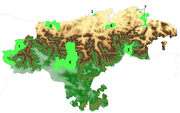
1. Picos de Europa National Park
2. Collados del Asón Natural Park
3. Dunas de Liencres Natural Park
4. Macizo de Peña Cabarga Natural Park
5. Oyambre Natural Park
6. Saja-Besaya Natural Park
7. Santoña, Victoria and Joyel Marshes Natural Park
Despite its small size, there are seven natural areas of undoubtable interest in this autonomous community designated as Natural or national parks:
- Picos de Europa National Park
- Collados del Asón Natural Park
- Santoña, Victoria and Joyel Marshes Natural Park
- Macizo de Peña Cabarga Natural Park
- Oyambre Natural Park
- Saja-Besaya Natural Park
- Dunes of Liencres Natural Park
The most important of these is the Picos de Europa National Park, which affects Castile and León and Asturias in addition to Cantabria, the three autonomous communities sharing its management. Santoña, Victoria and Joyel marshes are also Special Protection Areas for the birds (ZEPA[8]).
Furthermore, nine Sites of Community Importance (LIC[9]) have been declared: Western Mountain, Eastern Mountain, Western Rias and Oyambre Dunes, Dunes of Liencres and Estuary of the Pas, El Puntal Dunes and Estuary of the Miera, Ria de Ajo, Marshes of Noja-Santoña, Escudo de Cabuérniga Range and several caves with important bat colonies.
Demographics
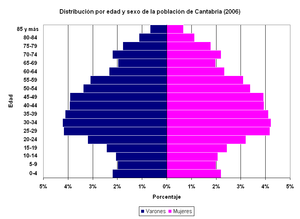
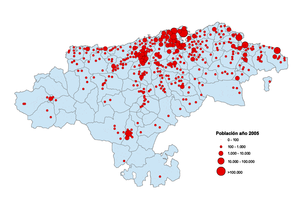
According to the 2009 Census, the region has a population of 591,886 [10] which constitutes 1.29% of the population of Spain, with the population density numbering 106.8 people per kilometer. The average life expectancy for male inhabitants is 75 years whilst for female inhabitants it measures 83 years.
In relative contrast to other regions of Spain, Cantabria has not experienced much immigration. In 2007, only 4.7% of the population were immigrants. The predominant countries of origin for immigrants to Cantabria are Colombia, Romania, Ecuador, Peru, Moldova, and Morocco.[11]
The majority of the population resides in the coastal area, particularly in two cities: Santander, with 183,000 people, and Torrelavega, the second largest urban and industrial center in Cantabria, having a population of around 60,000. These two cities form a conurbation known as the Santander-Torrelavega metropolitan area.
An interesting case is that of Castro Urdiales. Despite the fact that it officially has a population of 28,542[12] making it the fourth-largest in the region, due to its proximity to the Bilbao metropolitan area, there are a large number of people not registered in Castro Urdiales and the true count may be double the official figure.
Apart from the ones as mentioned, the most important municipalities of Cantabria are the following:
- Torrelavega (pop. 55,947)
- Camargo (pop. 32,000)
- Castro-Urdiales (pop. 31.670)
- Piélagos (pop. 20,081)
- El Astillero (pop. 17,360)
- Laredo (pop. 12,591)
- Los Corrales de Buelna (pop. 11,610)
- Santoña (pop. 11,569)
- Reinosa (pop. 10,307)
- Santa Cruz de Bezana (pop. 11,279)
History
Roman Empire
The first written reference to the name Cantabria emerges around the year 195 BC, in which the historian Cato the Elder speaks in his book Origins about the source of the Ebro River in the country of the Cantabri:
... fluvium Hiberum; is oritur ex Cantabris; magnus atque pulcher, pisculentus.—Cato the Elder, Origines: VII
From then on, there are continuous references to the Cantabri and Cantabria, as the Cantabri were used as mercenaries in various conflicts, both within the Iberian Peninsula and elsewhere. It is certain that they participated in the war of the Carthaginians against Rome during the Second Punic War, from references by Silius Italicus (Book III) and Horace (Book IV, Ode XIV). They are also mentioned during the siege of Numantia waged by Gaius Hostilius Mancinus, who is said to have lifted the siege of the city and fled upon being informed that Cantabri and Vaccaei were present among his auxiliaries.
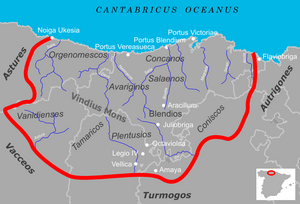
The majority of the references in the following period are related to the Cantabrian Wars against Rome which began in the year 29 AD. Roughly 150 references can be found in Greek and Latin texts, attesting to the notoriety of the Cantabri. Their territory was significantly larger than that of modern day Cantabria, bounded on the north by the Cantabrian Sea (the name used by the Romans to refer to the Bay of Biscay), and on the west by the western edge of the Sella River valley (in modern day Asturias). To the south it extended as far as the hill fort of Peña Amaya, in the modern-day province of Burgos, and to the east almost up to Castro Urdiales, in the vicinity of the Aguera River.
Middle Ages
Following the collapse of the Roman Empire, Cantabria regained its independence from the rule of the Visigoths. In the year 574, King Liuvigild attacked Cantabria and managed to capture the south of the country, including the city of Amaya, where he established a Visigoth province called the Duchy of Cantabria (see picture), which would serve as a limes or frontier zone to contain the Cantabri as well as their neighbors the Vascones. To the north of this cordon, however, the Cantabri continued to live independently until the Arab invasion.
In the year 714, a mixed Arab/Berber army of Muslim Moors invaded the upper valleys of the Ebro and succeeded in capturing Amaya, the Cantabrian capital, forcing the Cantabrians to stick to the traditional war frontiers, in order to organize their defense, and early joined the Kingdom of Asturias.
In the first chronicles of the Reconquista, Cantabria still appears to be acknowledged as a region. In the Albendense chronicle, when speaking of Alfonso I it says “iste Petri Cantabriae ducis filius fuit[13]”, referring to the figure of Peter and the title of Duke of Cantabria, confirming the territory of his duchy.
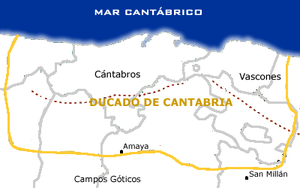
From this period on, source documents barely reference Cantabria by this name, with the name Asturias predominating in mentions of the comarcas called Asturias de Santillana, Asturias de Trasmiera and Asturias de Laredo.
From the central core formed by the Brotherhood of the Four Cities (Santander, Laredo, Castro Urdiales and San Vicente de la Barquera), the Brotherhood of the Marshes was created, thereby uniting all the important seaports to the East of Asturias.
During the period of the Reconquista, the Four Cities actively participated in the re-settling of Andalusia, dispatching men and ships. The coastal port cities of Cádiz and El Puerto de Santa María were repopulated by families from the ports of the Cantabrian Sea. Ships from the Four Cities also took part in the taking of Seville, destroying the ship bridge linking Triana and Sevilla, a war achievement that is pictured with a Carrack and the Torre del Oro of Sevilla in the coat of arms of Santander, Coat of arms of Cantabria and Avilés (Asturias).
16th to 18th centuries
In the 16th century the name La Montaña (The Mountain) was widespread in popular usage and in literature, as a designation of the Ancient Cantabria, as opposed to Castile, which referred solely to the Central Plateau. This distinction has survived into modern times.
With the rise of the Catholic Monarchs, the Brethren of the Marshes disappeared, leaving the Coregiment of the Four Villas, which included the whole are of influence of the old Brethren of the Four Villas (almost the entire Cantabria).
During the Ancien Régime the greatest jurisdictional lordships of Cantabria were mainly under the control of three of the Grandee families of Spain: that of Mendoza (Dukes of Infantado, Marquises of Santillana), of Manrique de Lara (Marquises of Aguilar de Campoo, Counts of Castañeda) and to a lesser extent that of Velasco (Dukes of Frías, Constables of Castile).
From the 16th century on, interest in studies related to Cantabria and the Cantabri reemerged, particularly around the issue of the precise location of the territory that this people occupied. It was not until the 18th century that the controversy about the location and extension of Ancient Cantabria was settled, thanks to works important for the knowledge of the history of the region such as La Cantabria[14] by the Augustinian father and historian Enrique Flórez de Setién. Concurrent with the resurgence of this interest in the Cantabrians and the clarification of the aforementioned polemic, many institutions, organizations and jurisdictions in the mountainous territory received the name of "Cantabrian" or "of Cantabria".
In 1727 the first attempt to unify what would later become the Province of Cantabria occurred. Despite this, the high level of autonomy that the small entities of the fractured estate of Cantabria enjoyed, combined with the proverbial lack of resources, continued to be the main reason for Cantabria's weakness, aggravated by the progressive advance of the Bourbonic centralism and its administrative efficiency. The latter continually underlined the impossibility of the smaller entities facing by themselves the multitude of problems of all kinds: from perennially difficult communications, to troubles in the exercise of justice, from difficulties in ensuring adequate reserves for hard times, to the indiscriminate levees for soldiers, and above all the progression of fiscal impositions. All of this worked toward the acceleration of contacts between villas, valleys and jurisdictions, which tended to focus on the Assemblies of the Provinces of the Nine Valleys, led by the deputies elected by the traditional entities of self-government.
There were two events that triggered the culmination of the integration process in this second attempt:
- On the one hand, the collective interest in avoiding making contributions to the reconstruction of the bridge of Miranda de Ebro, imposed by order of the Intendant of Burgos on July 11, 1775, the same year that Cantabria suffered two tremendous floods, on June 20 and November 3.
- On the other hand, the necessity to face as a whole mancomunidad (commonwealth) the large number of bandits who operated with impunity in Cantabria, as a result of a judicial system made ineffectual by a lack of resources.
After the General Deputy of Nine Valleys gathered the affected jurisdictions to the Assembly that was to take place in Puente San Miguel on March 21, 1777, they sent their respective deputies with sufficient authority to join with the Nine Valleys, to "unite and associate ourselves" or "to be one with the rest", as the Council of Pie de Concha stated.
In this General Assembly a framework was established and formal steps began to be taken, leading to administrative and legal unity in 1778. This all culminated in the success of the Assembly held in the Assembly House of Puente San Miguel on July 28, 1778, where the Province of Cantabria was constituted. It was achieved by passing the common ordinances which had been developed to that end, and which had beed discussed and approved previously in councils of all the villas, valleys and subscribed jurisdictions. They were, in addition to the Nine Valleys: Rivadedeva, Peñamellera, the Province of Liébana, Peñarrubia, Lamasón, Rionansa, the Villa of San Vicente de la Barquera, Coto de Estrada, Valdáliga, the Villa of Santillana del Mar, Lugar de Viérnoles, the Villa of Cartes and environs, the Valley of Buelna, the Valley of Cieza, the Valley of Iguña with the Villas of San Vicente and Los Llares, the Villa of Pujayo, the Villa of Pie de Concha y Bárcena, the Valley of Anievas, and the Valley of Toranzo.
Having learned a lesson from the failed attempt of 1727, the first objective of the new entity was to obtain approval from King Charles III for the union of all the Cantabrian jurisdictions into one province. The royal ratification was granted on November 22, 1779.
The twenty eight jurisdictions that initially comprised the Province of Cantabria very clearly expressed their intention that all the rest of the jurisdictions that formed the Party and Baton of the Four Villas of the Coast be included in the province. Consequently, they facilitated the integration in a variety of ways, with the aim of bringing it to fruition as soon as they requested it. They would have to abide by the ordinances, having the same rights and duties as the founders, all on an equal footing. Thus, the following joined in succession: the Abbey of Santillana, the Valleys of Tudanca, Polaciones, Herrerías, Castañeda, the Villa of Torrelavega and environs, Val de San Vicente, Valle de Carriedo, Tresviso, and the Pasiegan Villas of La Vega, San Roque and San Pedro, as well as the city of Santander with its Abbey.
As a result of the competition between Laredo and Santander, the township of the latter, having initially allowed the name of Cantabria for the province created at the beginning of the 19th century, later reacted and demand that it bear the name of Santander, so there would be no doubt as to which was the capital. When in 1821 the Provincial Council presented before the constitutional Courts the definitive plan for the provincial borders and legal entities, they proposed the name of Province of Cantabria, to which the Township of Santander replied that "this province must retain the name of Santander". However, many newspapers still showed in their headings the name of Cantabria, or Cantabrian.
19th century
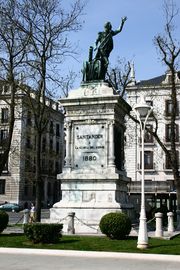
During the War of Independence (1808–1814), the bishop Menéndez de Luarca, a strong defender of absolutism, promoted himself as the "Regent of Cantabria" and established the Cantabrian Armaments in Santander, a section of the army whose purpose was to travel to all the mountain passes from the Central Plateau to detain any French troop. Although defeated, he managed to later reorganize in Liébana under the command of general Juan Díaz Porlier, calling it the Cantabrian Division, in which there were various regiments and battalions, such as the Hussars of Cantabria (cavalry) or the Shooters of Cantabria (infantry). During the Carlist wars they formed a unit called the Cantabrian Brigade.
20th century
The marked increase of the use of terms with an ancestral resonance through the 18th century and all the 19th, continued during the 20th century, taking on a political tone that was distinctly regionalist, until 1936. In fact, the Republican Federal Party produced an autonomy statute for a Cantabrian-Castilian Federal State that year, which would include nowadays Cantabria and all the nearby areas from Castile and Asturias that would like to join in. It couldn't be passed because of the Civil War. As a consequence of the war and the subsequent marginalization of these efforts under Franco's regime, the use of the name of Cantabria decreased, to the point that for official purposes it was relegated to sports associations, the only arena in which Cantabria was noted as a region.
In 1963 the president of the Province Council, Pedro Escalante y Huidobro, proposed reapplying the name of Cantabria to the Province of Santander, in accordance with a scholarly report written by the chronicler Tomás Maza Solano. Notwithstanding active steps taken and the affirmative vote from the townships, the petition wasn't successful, mostly due to the opposition of the City of Council of Santander.
On December 30, 1981 a process started on April 1979 by the Council of Cabezón de la Sal, under the presidency of Ambrosio Calzada Hernández, was brought to completion. This municipality initiated the process outlined by Article 143 of the Spanish Constitution to bring the self-rule to Cantabria. An additional 85 townships of the region and the Province Council also signed on to the proposal of the Town Council of Cabezón de la Sal.
Cantabria based its claim to autonomy on the constitutional precept that made provision for self government for "provinces with a historic regional character".
The Mixed Assembly, formed by the province deputies and the national members of parliament, initiated the tasks for the composition of the Autonomy Statute on September 10 of 1979. After the approval of the General Courts on December 15, 1981, the King of Spain signed the corresponding Organic Law of the Autonomy Statute for Cantabria on December 30 of the same year. Thus, the province of Santander broke its link to Castile, and exited the pre-autonomy regime of Castile and León to which it had belonged up to that time, together with the provinces of Ávila, Burgos, León, Logroño, Palencia, Salamanca, Segovia, Soria, Valladolid and Zamora.
On February 20, 1982 the first Regional Assembly (now Parliament) was formed, with provisional status. From then on, the former province of Santander has been known as Cantabria, and has thereby regained its historic name. The first home-rule elections were held in May 1983.
The 4th Legislature (1995–1999) brought into effect the first great reform of the Autonomy Statute of Cantabria, approved by all the parliamentary groups.
Government and administration
The Autonomy Statute of Cantabria[15] of December 30, 1981, established that Cantabria has in its institutions the will to respect the fundamental rights and public freedom, at the same time it consolidates and stimulates regional development, based on democratic relationships. This document gathers all competences of the Autonomous Community that were transferred from the Government of Spain. It must be remarked that, as in other Communities, some fields haven't been transferred, as the Justice, for instance. The Statute also defines the symbols that should represent the region: The flag, the coat of arms and the anthem of Cantabria.
The Parliament of Cantabria[16] is the principal self government institution of the Autonomous Community, being the representative body of the Cantabrians. Presently it is constituted by thirty nine deputies elected by universal, equal, free, direct and secret suffrage.
The primary functions of the Parliament are: to exercise the legislative power, to approve the budgets of the Autonomous Community, to motivate and control the actions of the government, and to develop the rest of the competences that the Spanish Constitution, the Autonomy Statute and the rest of the legal order bestow on it.
The President of the Autonomous Community holds the highest representation of the Community and ordinary representation of the Country in Cantabria, and presides over the Government, coordinating its activities. He is elected by the Parliament among its thirteen members, after query to the politic groups represented in it, and he is appointed by the King. He must present his politic program to the full chamber, and be granted absolute majority in first session or simple in subsequent.
The Government of Cantabria[17] is the body in charge of directing the political activities and exercising the executive and regulatory powers according to the Constitution, the Statute and the laws. The Government is made up of the President, the Vicepresident (in which the President can delegate his executive functions and representations) and the Councillors, who are appointed and ceased by the President.
After several legislatures presided by the Partido Popular or by Juan Hormaechea's UPCA, the Regional Government of Cantabria is directed by a coalition of the Regionalist Party of Cantabria and PSOE from year 2003. The current President is Miguel Ángel Revilla of PRC, and the Vicepresident is Dolores Gorostiaga of PSOE.
Territorial organization
The autonomous community of Cantabria is structured in municipios (municipalities) and comarcas (regions).
Municipalities
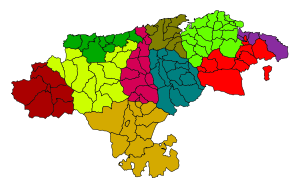
There are currently 102 municipalities in Cantabria generally comprising of several townships, and from these, several districts. A number of municipalities bear the name of one of their townships (be it its capital or not), but not all them do. Each municipality is governed by its own city or municipal council, and two of them, Tresviso and Pesquera, do it by Concejo abierto (Open council), having less than 250 inhabitants.
It should be noted that the Mancomunidad Campoo-Cabuérniga isn't a municipality as such, despite its extension. It is a communal property, singular for its size and characteristics, of shared management between the municipalities of Hermandad de Campoo de Suso, Cabuérniga, Los Tojos and Ruente. This mountain estate is used as a grazing ground for Tudanca cattle and also for horses in less amount, in its brañas or grass prairies, and even nowadays transhumant cattle farming traditions survive in this region.
See also:
- List of municipalities in Cantabria
Comarcas (regions)
The Cantabrian legislation divides the autonomous community in administrative regions called comarcas, but traditionally, other subdivisions of the territory have been used.
- Administrative regions
The Law 8/1999 of Comarcas of the Autonomous Community of Cantabria of April 28, 1999 establishes that the comarca is a necessary entity, integral in the territorial organization of the region. This law opens the development of the comarcalization in Cantabria promoting the creation of comarcal entities, which have barely begun to appear. The law also establishes that the creation of comarcas won't be mandatory for the whole territory until at least the 70% of it hadn't been comarcalized by its own will. Likewise it states that the city of Santander won't be ruled by said law of comarcalization, as it should establish its own metropolitan area instead.
Currently, comarcas in Cantabria have not reached administrative nature and barely have definite borders. Only Liébana for its geographic position in Picos de Europa, Trasmiera and Campoo, in the Ebro basin are established are clearly defined comarcas in the region. Nevertheless, functional differences in the territory can be distinguished, dividing it in the following areas: Santander Bay, of industrial and urban nature; Besaya, also industrial; Saja-Nansa, eminently rural; Western Coast, which has urban character; Eastern Coast, vacational; the traditionally renown Trasmiera; rural Pas-Miera; Asón-Agüera, also mainly rural; the very well defined Liébana, and Campoo-Los Valles, rural and industrial by regions.
- Natural regions (regarding geographical features)
- Coastal strip
- Central strip (Cantabrian valleys perpendicular to the coast): Liébana, Saja and Nansa, Besaya, Pas and Miera, and Asón-Gándara valleys.
- Southern strip (Rivers Ebro and Duero's basins): Campoo and Southern valleys
- Historic regions
Until the 13th century, Cantabria was organized in valleys, as was typical in all of northern Spain. From then on, it was substituted by the organization in cities, towns or historic comarcas that grouped several valleys. The most remarkable were Liébana, Asturias de Santillana, Trasmiera, Campoo and Valderredible
Economy
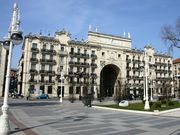
The economy of Cantabria has primary industry, now in decline, employing 5.8% of the active population in the sectors of cattle farming, traditional dairy farming, and meat production; agriculture, especially corn, potatoes, vegetables, and roughage; maritime fishing; and the mining of zinc and quarries.
The secondary industry which employs 30.3% of the active population is the sector with the most productivity in recent years due to construction; that of ironworking, food service, chemistry, paper production, textile fabrication, pharmacy, industrial groups and transport, etc. .
The service sector employs 63.8% of the active population and is increasing, given that large concentrations of the population live in the urban centers and the importance that tourism has acquired in the recent years.
The unemployment rate in Cantabria, as of April 2010 is 14.49%, compared to 20.05% in Spain; while its purchasing power parity is 25.326€, compared to 26.100€ in Spain and 25.100€ in the EU25. In 2007 Cantabria's growth of real GDP was 4.1%, compared to a 3.9% average for Spain.
Transportation and communications
The most significant consequence of the strong relief of the Cantabrian territory is the existence of topographic barriers that condition decisively the courses of the linking infrastructures, as much in the north-south orientation in the accesses to the Castilian Mesa, as in the east-west in the communication between valleys. Moreover, the cost of their construction and maintenance is much higher than average. This fact is specially remarkable in the Mountain, with roads and railways with slow and winding courses in order to avoid the greater slopes, that being the most problematic and distinct characteristic of the communication network of Cantabria.
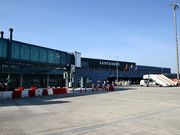
An interesting case is the Cantabrian village of Tresviso. To access it by road you have to go via the neighbouring province of Asturias. The only way in or out of the village, famous for its blue cheese, from Cantabria is on foot.
The main communications infrastructures of the region are:
- Santander Airport
- Cantabrian Motorway (Autovía A-8, European route E-70)
- Cantabria-Meseta Motorway (Autovía A-67) (in construction)
- Narrow-gauge railway Santander-Oviedo (FEVE)
- Narrow-gauge railway Santander-Bilbao (FEVE)
- Broad-gauge railway Santander-Palencia-Valladolid-Ávila-Madrid (RENFE)
- Broad-gauge high-speed railway Santander-Torrelavega-Valladolid-Segovia-Madrid (RENFE)
- Ferry line Santander-Plymouth
- Port of Santander
Mass media and public opinion
In Cantabria there are two daily regional newspapers in addition to the national ones: El Diario Montañés and Alerta, as well as many weekly, fortnightly and monthly publications.
The main national radio stations have transmitter stations in places like Santander, Torrelavega, Castro-Urdiales, or Reinosa. There are also numerous local and regional stations. For the moment there is no Cantabrian autonomic television with public financing, although some local channels exist (including Canal 8 DM, TeleBahía, Telecabarga, Localia TV Cantabria, etc.).
In recent years, the Internet has allowed new informative proposals to emerge in the shape of digital diaries or blogs, which contribute to enrich the mediatic panorama of the region.
Culture
-Museo_Arqueológico_Nacional.jpg)
Language
Spanish is the official language of Cantabria. The eastern part of Cantabria contributed to the language's origins in a significant way. Cantabrian language, or Mountain language, is hardly preserved in the West of Cantabria and some zones of the Pas Valley and the Valley of Soba, in its Eastern zone. This language has neither regulation nor official recognition.
Monuments and museums
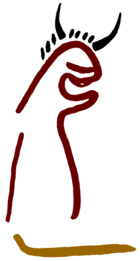
- Caves: Altamira Cave, El Soplao, Del Valle, El Pendo, La Pasiega Cave, Las Monedas, El Castillo, Morín, and others.
- Civil architecture: Magdalena palace, Capricho de Gaudí, Pontifical University of Comillas, Sobrellano palace, Bárcena palace, Castle of Argüeso, and others.
- Religious architecture: Collegiate of Santillana del Mar, Collegiate of Santa Cruz de Castañeda, Santo Toribio de Liébana Monastery, Santa María de Lebeña, Santa María de Piasca, Santa María del Puerto, and others.
- Museums: Cantabrian Sea Maritime Museum, Ethnographic Museum of Cantabria, Santander Museum of Fine Arts, Regional Museum of Prehistory and Arqueology of Cantabria, Cantabrian Museum of Nature, Altamira National Museum and Investigation Centre, and others.
Universities
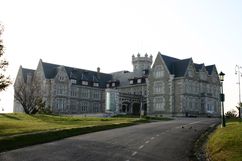
- University of Cantabria (UC, UNICAN)
- International University Menéndez Pelayo (UIMP)
- Universidad Nacional de Educación a Distancia (UNED)
- Campus Comillas (CIESE-CC)
Fairs and festivals
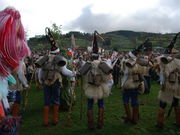
Regarding the fairs, understood as big markets of products periodically celebrated, it is remarkable the Livestock Fair of Torrelavega taking place in the National Livestock Market "Jesús Collado Soto", the third biggest of Spain, that groups the buy and sell of all kinds of cattle in the region itself and the adjacent ones, being the bovine the main product. All over the region cattle and typical products fairs are celebrated weekly, monthly, or annually to gather the neighbours of the land.
There are many different festivities in Cantabria, some of them limited just to small villages, but there are also festivals that attract tourism from all the country. The most important are the following:
- Carnaval marinero (Sailor Carnival), in February in Santoña. Commonly known as "the carnivals of the North", in this carnival, started in 1934, many people of the town participate dressing themselves up as fish. The main event is the "Trial at the bottom of the ocean", where the "besugo" is judged before the last act, "The burning of the besugo". (A besugo is a foolish person besides a type of fish).
- La Folía, April in San Vicente de la Barquera, a parade of local fishing boats following one with a statue of the Virgin.
- Coso Blanco, first Friday in July in Castro Urdiales. Colorful parade with carts.
- Cantabria Day, second Sunday of August in Cabezón de la Sal. Traditional Cantabrian music, ceramics fair, local foods, bowling championships, ox dragging contests and public speeches.
- SAUGA folk music festival, celebrated the third weekend of August in Colindres.
- Floral Gala, August en Torrelavega. A festival of international touristic importance with carts decorated with flowers.
- Battle of Flowers, August, in Laredo. Carts decorated with flowers and fruit. Fireworks in the evening.
- Campoo Day, September in Reinosa. Tourist fair of regional importance since 1977 and celebrated since the 19th century, it shows customs and traditions of the Campurrians in their capital. Cattle shows, local products market and regional costumes are the items in this festival.
The following festivals are also remarkable in modern Cantabrian culture: Santander International Festival[19] (Arts festival), Santander Summer Festival[20] (Music festival), Sotocine[21] (Film festival)
Mythology
Northern Spain is a rich area for mythology. In the whole Green Spain, from Galicia to the Basque Country, passing by Asturias and Cantabria, there are rites, stories and imaginary or impossible beings (or maybe not so).
The mythology of Cantabria turns the Cantabrian forests and mountains into magical places where the myths, beliefs and legends have been present as an essential part of the Cantabrian culture, either because they have been living in the popular heritage through the oral tradition transmitted from father to son, or because they have been recovered by scholars (Manuel Llano and others) who have worried about preserving the cultural heritage. Its mythology and superstitions present a great Celtic influence that has diluted with the pass of time, being romanized or Christianized in many cases. It is remarkable, as in many other cultures, the presence of faboulous beings of giant proportions and cyclopean features (the ojáncanos), fantastic animals (culebres, caballucos del diablo (lit. horses of the devil, damselflies), ramidrejus, etc.), færies (anjanas, ijanas of Aras), duendes (nuberos, ventolines, trentis, trasgus, trastolillos, musgosu, tentirujo), anthropomorphic characters (the sirenuca (little mermaid), the fish-man, the cuegle, the wife-bear of Andara, the guajona), etc.
Cuisine
- Typical dishes: cocido montañés (Highlander stew) made with beans and collard greens, cocido lebaniego (Liébanan stew) made from chickpeas, marmita or sorropotún (similar to marmitako), and olla ferroviaria (Railway pot), as main courses.
- The livestock farming reputation of the region and its climatologic conditions in favour for cattle breeding allowed the European Union to pass the "Meats of Cantabria" denomination as a Protected Geographic Denomination for the beef of certain kinds of native races (Tudanca, Monchina, Asturian of the valleys and Asturian of the mountain), and other adapted to the environment (Limusina) or integrated by assimilation (Brown alpine).
- Fish and seafood: Anchovies of Santoña, Colindres, Laredo and Castro Urdiales, angler, hake, Sea bass, sole, mackerel, sardine, European anchovies, bonito of the North (of Spain), gilt-head bream, sea bream, scorpionfish, red mullet, as well as some river fish as trout and salmon. Rabas (fried calamari) and cachón en su tinta (cuttlefish cooked in its own ink). Regarding seafood, it can be remarked: clam, mussel, muergos (jackknife), cockle, velvet crab, spider crab, goose barnacle, lobster, Norway lobster, periwinkle or European lobster.
- Desserts: Quesadas and sobaos of the Pas valley, frisuelos from Liébana (similar to crêpes), Unquera's corbatas (neckties) and Torrelavega's polkas (both basically puff pastry), sacristanes in Liérganes, Palucos de Cabezón de la Sal and pantortillas of Reinosa.
- Cheeses: Spicy cheese of Bejes-Tresviso, quesucos (little cheeses) of Liébana, cream cheese, etc. (many of them with PDO).
- Drinks: apple cider and orujo (liquor made from pomace) from Liébana, with its variations: (orujo cream, orujo with honey, herbal orujo, etc.); chacolí, and tostadillo of Potes.
Sports
The traditional sport of Cantabria is the game of balls[22] (skittles) in its four forms: Bolo palma, pasabolo tablón, pasabolo losa and bolo pasiego. The first one is the most extended, exceeding regional nature and reaching the eastern zone of Asturias and also being the most complex in its game rules. The existence of boleras or skittle rings is important in every Cantabrian township, often being near the church or the village pub.
From the late 1980s, skittle play has consolidated with the reinforcement of skittle schools, revamped by the different town councils and Cantabrian institutions, the various competitions (League, Cup championships, Regional and National Circuits, etc), or the expansion in the media due to the social interest. Sometimes bolos can also refer to the American bowling, which can also be played at malls and similar in the cities.
As in the whole North coast of Spain, particularly in Cantabria and the Basque Country, the remo (rowing) is a very traditional sport in the coastal towns. The origins of rowing in Cantabria go back many centuries, when several traineras (traditional fishing longboats) competed for the selling of the caught fish, which was reserved for the first ship to arrive to the fish market. At the end the 19th century work became sport and people started to celebrate regattas between Cantabrian townships. The sport clubs of Cantabria, specially the Astillero, Castro Urdiales, and the Pedreña belong to the most prize-winning teams of the history of this sport, and nowadays they are having one of the best moments after a decades-long period of trophy drought.

The Pasiegan jump is another of the outstanding rural sports of the region and a clear example of how the use of a work skill that disappears with the pass of time, gives rise to games and competition. Similar to other forms, like the Canarian shepherd jump, in the beginning this technique was used in the Pasiegan valleys to cross the stone walls, the fences, the creeks or the ravines that bordered the fields and obstructed the pass in the abrupt geography of the highland areas of Cantabria.
Referring to mass sports, Cantabria is present in national and international competitions through teams such as the Racing de Santander, the RS Gimnástica de Torrelavega and the Cantabria autonomous football team in football; the Club Balonmano Cantabria that has won several Leagues and King's Cups as well as international titles in handball; or the Cantabria Lobos that has played in the ACB in basketball.
Notable Cantabrians
Cantabria has been the birthplace of exceptional and notable individuals in fields such as literature, arts, sciences, etc. Many of them have played a decisive role, not only in the history and events of the region, but also on the national and international levels. These include:
- Military: Laro, Corocotta, Pedro Velarde.
- Religion: San Emeterio, San Celedonio, Beatus of Liébana.
- Explorers: Juan de la Cosa, Vital Alsar, José de Bustamante y Guerra.
- Literature: José María de Pereda, Concha Espina, Gerardo Diego, Manuel Llano, Álvaro Pombo, Amós de Escalante.
- Painting: María Blanchard, Casimiro Sáinz, José de Madrazo.
- Science and technology: Leonardo Torres Quevedo, Augusto González Linares, Juan de Herrera.
- Politics: Luis Carrero Blanco, Alfredo Pérez Rubalcaba, Joaquín Leguina, Miguel Ángel Revilla.
- Music: Jesús de Monasterio, Ataúlfo Argenta, David Bustamante, La Fuga.
- Sports: Francisco Gento, "Santillana", José Manuel Abascal, Severiano Ballesteros, Óscar Freire, Vicente Calderón.
- Film, radio, and TV: Juan Manuel Gozalo, Mario Camus, Manuel Gutiérrez Aragón, Eduardo Noriega, Antonio Resines, Nacho Vigalondo.
- Other: Emilio Botín, Jesús de Polanco, Ángel Schlesser, Francisco González Gómez
See also Category:Cantabrian people
See also
- Architecture of Cantabria
References
- This article draws heavily on the corresponding article in the Spanish-language Wikipedia, which was accessed in the version of March 31, 2007.
- ↑ (Spanish)"La Ley Orgánica 11/1998, de 30 de diciembre, de reforma de la LO 8/1981, del Estatuto de Autonomía para Cantabria (BOE 31 diciembre 1998). El Estatuto deja de referirse a Cantabria como "entidad regional histórica", expresión empleada por la propia Constitución (art. 143) para permitir la existencia de comunidades uniprovinciales, para ser sustituida por la expresión "comunidad histórica" (art. 1).Sinopsis del Estatuto de Cantabria Ignacio Carbajal Iranzo, Letrado de las Cortes Generales. Updated by Portal de la Constitución. 2005. Updated 2007. Retrieved on 2007-06-09
- ↑ González Echegaray, Joaquín (1993). Los cántabros. Editorial Estudio. ISBN 84-87934-23-4.
- ↑ (Spanish) Confederación Hidrográfica del Norte. Ministerio del Medio Ambiente. Retrieved on 2007-06-09.
- ↑ (Spanish) Confederación Hidrográfica del Ebro. Ministerio del Medio Ambiente. Retrieved on 2007-09-09.
- ↑ (Spanish) Confederación Hidrográfica del Duero. Ministerio del Medio Ambiente. Retrieved on 2007-06-09.
- ↑ This events constitute the background of La vida que te espera, a film by Cantabrian-born director Manuel Gutiérrez Aragón
- ↑ "Tercer Inventario Forestal Nacional". Mma.es. http://www.mma.es/secciones/biodiversidad/inventarios/ifn/ifn3/index.htm. Retrieved 2010-04-27.
- ↑ (Spanish) Programa de Vigilancia Ambiental del Plan Nacional de Regadios. Ministerio de Agricultura, Pesca y Alimentación (M.A.P.A.) Retrieved on 2007-06-09.
- ↑ (Spanish) Biodiversity: Lugares de Importancia Comunitaria. Ministerio de Medio Ambiente. Retrieved on 2007-06-09.
- ↑ (Spanish) Poblaciones referidas al 1 de enero de 2006 por comunidades autónomas y sexo. Instituto Nacional de Estadística. Retrieved on 2007-06-11.
- ↑ (Spanish) Población extranjera según su nacionalidad y sexo (2004-2006) (PDF). Instituto Cántabro de Estadística (ICANE). Retrieved on 2007-06-09.
- ↑ (Spanish) Cantabria: Población por municipios y sexo. Cifras de población referidas al 01/01/2006. Instituto Nacional de Estadística. Retrieved on 2007-06-11.
- ↑ This was son of Peter the Duke of Cantabria.
- ↑ Enrique Flórez. La Cantabria. Disertación sobre el sitio y extensión que tuvo en tiempos de los romanos la región de los cántabros, con noticia de las regiones cofinantes y de varias poblaciones Antiguas (The Cantabria. Dissertation of the place and extension that that the land of the Cantabri had in times of the Romans, with notice of the adjacent regions and of several Ancient villages. Madrid. 1768
- ↑ (Spanish) Constitución española: Estatuto de Autonomía de Cantabria. Congreso de los Diputados: España. Retrieved on 2007-06-09.
- ↑ (Spanish) Actividad Parlamentaria. Parlamento de Cantabria. Retrieved on 2007-06-09.
- ↑ (Spanish) Consejo de Gobierno. Gobierno de Cantabria. Retrieved on 2007-06-09.
- ↑ Owen, Edward (March 14, 2009). "After Altamira all is decadence". The Times (London). http://www.timesonline.co.uk/tol/travel/specials/artistic_spain/article5904206.ece. Retrieved April 28, 2010.
- ↑ (Spanish) Festival Internacional de Santander website
- ↑ (Spanish) Santander Summer Festival website
- ↑ (Spanish) Sotocine website
- ↑ (Spanish) History of the Bolos in Cantabria. Selaya Township website. Retrieved on 5 August 2007.
Bibliography
- Echegaray González, J. (1993). Los cántabros. Santander: Estvdio, 1993. ISBN 84-87934-23-4.
- VV.AA.:Guía de la naturaleza de Cantabria. Santander: Estvdio, 1993. ISBN 84-87934-21-8
- VV.AA.: Gran Enciclopedia de Cantabria. Santander: Cantabria, 1985 (8 tomos) y 2002 (tomos 9, 10 y 11). ISBN 84-86420-00-8
- VV.AA.: Cantabria 1898-1998. Un siglo de imágenes. Santander: Caja Cantabria, 1999.
External links
- Camara de Comercio de Cantabria
- Travel guide and pictures of Cantabria (Spanish) (English)
|
|||||||||||||
|
|||||||
